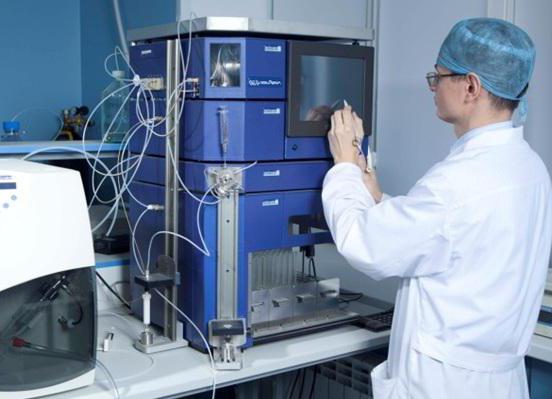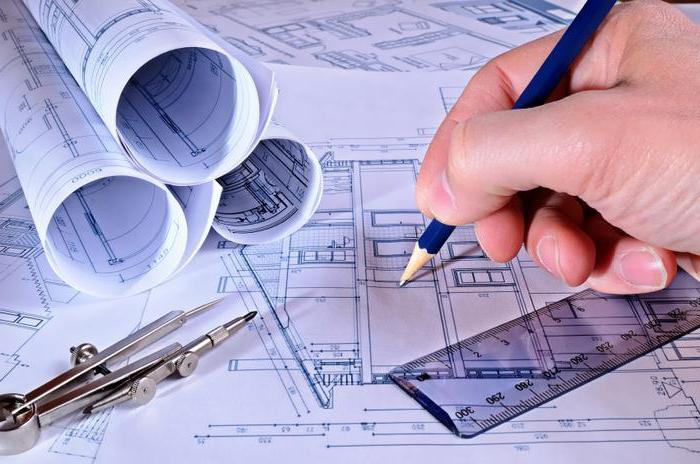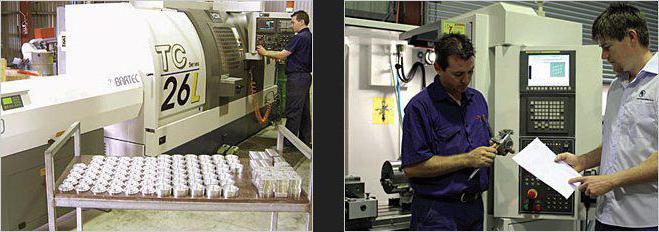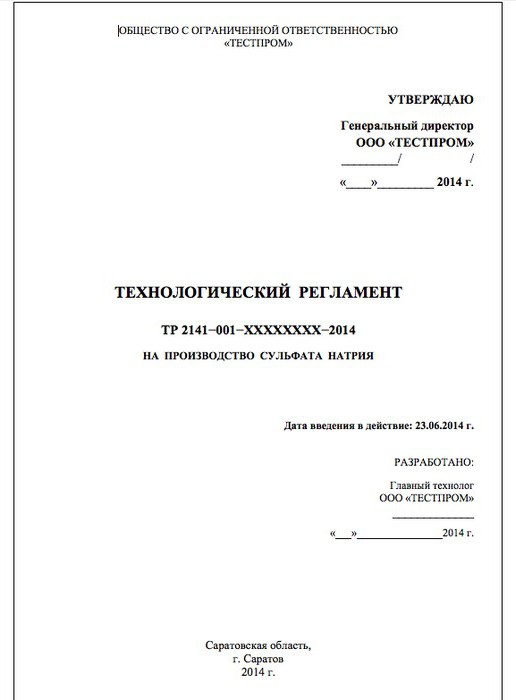Technological regulations definition. Technological regulations for the oil and gas industry
Technological regulations(TR) - a normative document of an enterprise for internal use, which establishes methods of production, technical means, technological standards, conditions and detailed procedure for the implementation of the technological process.
This document allows you to finished products in terms of quality that meets the requirements of Russian or international standards. Also, the Technological Regulations introduce the most safe ways conducting work, which at the same time contribute to the achievement of optimal technical and economic indicators of production.
The Technological Regulations prescribe all production processes with a high degree of detail:
- what operations and how to perform in different situations;
- how to conduct the mode correctly;
- what temperatures, pressures and flow rates to withstand;
- how to correctly change the main technological parameters and characteristics;
- what and in what sequence to open / close.
Technical documentation and Technological regulations
There is ESTD - the Unified System of Technological Documentation, which is part of the ESTP - the Unified System technological preparation production.
In accordance with the provisions defined in these systems, the development of the technical documentation of the enterprise is provided by the organization itself. Third-party organizations or specialists may be involved in the creation of technical documentation. In cases established by law, technical documentation is registered with supervisory organizations.
Required technical documentation for detailed description technological processes, characteristics of production, methods and methods of manufacturing products and their control. Registration of technical documentation may be required in the following cases:
- When issuing certificates of conformity;
- when making contracts;
- when conducting inspections by supervisory authorities.
Technical documentation can be divided into three large groups. This is the technical documentation:
- For technological processes;
- for products;
- to the quality management system.
The main technological document of the ESTD is the route map.
Description of technological production processes contained in the Technical Regulations. In addition to them, there are also enterprise standards, technological maps, technological and work instructions for processes, methods and other technical documentation. The technological regulation is the main working document for engineering and technical personnel and workers involved in the production process at a given enterprise.
Development of Technological regulations
Provisions for the development of Technological regulations, as a rule, are industry or departmental documents. Often there are and can be used in the development of standard TR. So the oil refining industry has more than 30 years of experience in developing such documents. There are industry guidelines for the development of TR, which were approved by the Order of the Ministry of Energy of Russia No. 393 dated September 30, 2003 and are valid within the oil and gas industry.
Technological regulations can be of three types:
- constants intended for the production of products according to a well-developed technological process;
- temporary - for new products being mastered, when using new equipment, or if major changes are made to the technology;
- one-time - for research work or for the release of a one-time batch.
Industry-wide documents that are regulatory in the development of Technological regulations are: Federal Law "On industrial safety dangerous production facilities” dated July 21, 1997 and the resolution of the Gosgortekhnadzor of Russia No. 77 December 18, 1998 - Regulations for the development of TR “Safe operation of production”.
The technological regulation contains the following sections:
- general characteristics production;
- description of the characteristics of materials, raw materials, reagents, semi-finished products;
- description of the technological process and technological scheme of production;
- norms of technology regimes;
- description of process control;
- description of the start and stop of production;
- description of the safe operation of production;
- waste description, Wastewater, emissions into the atmosphere, indicating the methods of their processing, disposal;
- a brief description of technological and pump-compressor, regulating and protecting equipment;
- list of normative documentation and mandatory instructions;
- graphic flow chart of production.
The period of validity of the Technological Regulations is determined by law, but, as a rule, is 5 years. After which, if no significant changes have occurred in production, then it is extended for another 5 years. If the enterprise is going to launch the production of new products or put new equipment into operation, then the TR is developed for 2 years.
Technological regulations can be processed ahead of schedule in cases provided for by law:
- With the introduction of new legislative acts on industrial safety;
- fundamental changes in production technology;
- if accidents have occurred due to the fact that safe operating conditions are not sufficiently reflected in the current TR.
Mandatory Technological regulations
In addition to the Technological regulations governing the direct production processes, there are TR " general purpose».
1. If the technological process is carried out with the use of explosive substances, materials or products, then the company must have a technological regulation fire safety. Approved on May 1, 2009, the "Technical Regulations on Fire Safety Requirements" is based on the old Technological Fire Safety Regulations using new concepts and terms.
2. When new construction of any type begins, the developer must have a Technological regulation for waste and waste management. This document reduces the risk negative impact pollution production environment helps to increase the efficiency of the use of natural resources.
AT technical regulations a list of waste is specified and a classification by hazard groups is determined, methods for removing garbage from construction sites are described, and places for its temporary storage are indicated. This normative document is unified. This Technological regulation is mandatory for all construction companies that generate construction waste as a result of technological processes. It is developed and approved by the Committee for Nature Management and Environmental Protection, which is present in each locality.
When do they end construction works regulated by the Gosstroy Certificate, the Technological Regulations must be closed. This procedure is also carried out at the Committee for Natural Resources, where certificates of acceptance of the object and the calculation of fees for the negative impact of production on the environment are provided.
3. Technological regulations for work treatment facilities is a document mandatory for enterprises with treatment facilities. Without it, it is impossible to perform work on connecting to the water supply network or sewerage. This Technological regulation establishes the rules for wastewater treatment. Based on the passport documentation for the cleaning equipment, the TR is issued by the developer or customer. Technological supervision authorizes the control of the operation of treatment facilities to reduce the risks of pollution of drains.
The technological regulation of production, a sample of which will be described below, is a regulatory document of a local nature. Subject to its requirements, the company produces products whose quality meets international and Russian standards. The document establishes methods, means, standards, detailed procedures and conditions for the creation of goods. The technological regulations for the use of waste for the production of products establish the most safe methods processing raw materials and creating new products from them.
Classification
Technological regulations for the production of products can be:
- Permanent. It is compiled for mastered production methods that ensure proper product quality.
- Starter (temporary). Such a document is created for new industries, as well as existing technologies, which are subject to fundamental changes.
- One-time. This regulation is intended for use in experimental and pilot workshops (at installations), when performing test work in active production.
- Laboratory. Such a regulation is being developed for model, bench installations that are not involved in the production of marketable products. According to these standards, trial production of products in the amount of up to 1 thousand kg / year is allowed.
Structure
All processes are detailed in the technological regulations for the production of products. In particular, the document states:

System unity
The procedure in accordance with which a regulatory document is drawn up establishes the Regulations on the technological regulations of production. It, in turn, is included in a single set of methodological recommendations for the preparation of enterprise lines for the production of products. According to the Regulations, the preparation of technical documentation is carried out directly by the organization itself. This process may involve third party businesses or individual professionals. In some cases provided for in the legislation, the documentation is registered by supervisory authorities. In particular, such a requirement contains the Regulations on technological regulations for chemical production.
When is a document needed?
The development of a production procedure may be required when:
- Registration of contracts.
- Carrying out inspections by supervisory authorities.
- Issuance of quality certificates.
All documentation can be divided into three categories. It can be made up of:
In addition, standards, maps, instructions, methods, etc. can be created. The technological production schedule, however, is considered the main regulatory document for personnel involved in the production of products at the enterprise.
Creation features
Regulations on technological regulations are, as a rule, departmental or industry documents. At the same time, there are standard standards. They can be used by the enterprise when developing its own technological regulations. Many organizations produce documentation based on industry methodological recommendations. They are approved by the order of the relevant Ministry and operate within a particular sector. Industry-wide documents that serve as the basis for the creation of technological documentation include:
- Federal Law regulating measures to ensure the industrial safety of hazardous facilities.
- Resolution of Gostekhnadzor No. 77 of December 18, 1998
Key Sections
- General description of production.
- Characteristics of materials, reagents, raw materials, intermediates.
- Description of the technological scheme and the process of production.
- Regime rules.
- Process control characteristic.
- Description of the start and stop of production.
- Characteristics of the safe operation of enterprise lines.
- Description of wastewater, emissions into the air, indicating the methods of their processing and disposal. This section is especially important in the preparation of technological regulations for chemical production.
- Characteristics of the safety, pump-compressor, control and other equipment involved in the processes.
- List of normative documents and obligatory instructions.
- Graphic scheme of production.
Validity periods
They are determined by law. Permanent technological regulations are valid for up to 10 years. Temporary regulations are drawn up for the period:
- Up to a year - if the period of development of new lines is less than 1 year.
- In the absence of a deadline for putting new production standards into operation, the duration of the technological regulation is determined by the person who approves it.
- At the end of the period for which the PR was drawn up, and if the enterprise fails to achieve the design indicators or if clarifications are made to the plan related to changes in capacity, volumes of raw materials costs, improvement in the quality of products, safety of operations, it can be extended. In these cases, it is also allowed to create a new temporary regulatory document.
Experimental technological regulations are drawn up:
- For the period of experimental operations or for the period of production of a specific volume of products.
- For 5 years - if necessary, to carry out the development of experimental goods for several years.
- For a period determined by the person approving the TR.
Situation in practice
The technological regulation of production is usually drawn up for a period of five years. In the absence of fundamental changes at the enterprise, the validity of the document is extended for 5 years. If the organization intends to launch the production of new products or put into operation improved equipment, the production schedule is created for 2 years. Revision of documentation may be carried out ahead of schedule. The legislation provides for cases when this is allowed:

Mandatory standards
In addition to special TR, through which the regulation of production processes is carried out, the legislation provides for "general purpose" regulations. They are required in the following cases:

Special cases
At the beginning of construction of any type. The developer organization is obliged to have technological regulations for waste and their handling. Such a regulatory document reduces the likelihood of a negative impact on the environment. Technological regulations for waste are also used at enterprises that process waste with subsequent use in production. This document contributes to increasing the efficiency of the use of natural resources. The technological regulations for the use of waste for the production of products indicate the groups of recyclable materials, their characteristics, methods of their processing. Construction companies in their normative documents give lists and classes of danger, methods of garbage removal from objects, areas of its temporary storage. Such regulations are developed and coordinated with the Committee for Environmental Protection and Nature Management. Construction organizations after the end of their activities at the facility, they are required to close the TR. This procedure is carried out in the same Committee. Certificates of acceptance of the structure, certificates on the calculation of payment for Negative influence on the environment.
Changes and additions
The current legislation allows amendments to be made to normative documentation. However, this procedure is strictly regulated. First of all, the proposed additions and adjustments should not adversely affect the safety of the technological process, the performance of production lines and the entire enterprise as a whole. Strict control over the process of making changes to the regulatory documentation eliminates cases of ignoring the new information included in it. Correction and addition of technological regulations is carried out in the following order:
- New information is entered into the "Registration Sheet".
- An order is issued through which adjustments and additions are put into effect. This executive document contains a description of the changes. They are written in paragraphs or whole sentences. This will ensure that the new information is quickly applied by the personnel of the enterprise. The order must be signed by the employee responsible for the technical and regulatory documentation in the organization.
- Items that have been corrected or supplemented must be marked accordingly. For example, "amend. 1" or "add. 2", etc. The marks opposite the items must correspond to the order in which orders are issued that introduce additions or adjustments into effect. Dates and signatures are not put next to the records.
- The introduced adjustments or additions should be sent to those departments of the enterprise in which the technological regulations are located and used.

All personnel involved in the production of products must be familiarized with the adopted changes against signature.
According to paragraph 16 of section 3 of the Federal norms and rules in the field of industrial safety "Safety rules in the oil and gas industry"(appr. Order of Rostekhnadzor dated March 12, 2013 No. 101), for each technological process at the facilities for the production, collection and treatment of oil, gas and gas condensate, a Technological regulations.
The technological regulation (TR) is the main document that defines the technology of the process or its individual stages (operations), modes and recipes for the production of products, product quality indicators, safe working conditions in accordance with the current regulatory and technical acts. TP also covers the development of measures and performance of work aimed at the safe operation of HIFs.
According to paragraph 1248 of the FNP "Safety Rules in the Oil and Gas Industry", the Technological Regulations must ensure safe working conditions at HIFs, operation of equipment in passport mode, economical process management, and specified product quality.
The standard period of validity of the technological regulation is 5 years (clause 1254 of the FNP). If the TR is developed for trial operation, testing of new equipment at the operating HIF with approved TR, then such a regulation is valid for 2 years.
In accordance with clause 1249 of the FNP, the person responsible for compliance with the requirements of the Technological Regulations for HIFs of the oil and gas industry is Chief Engineer or other technical manager of the operating organization.
Why develop technological regulations
Mandatory development of Technological regulations for HIFs of the oil and gas industry is established by paragraph 16 of the FNP "Safety Rules in the Oil and Gas Industry" (and other paragraphs according to the text of this regulatory act).
Previously, the need to prepare Technological regulations for oil refineries was regulated by clause 2.2 of PB 09-563-03 (approved by Decree of the Federal Mining and Industrial Supervision of Russia dated May 29, 2003 No. 44), which still remain a valid document, but refer us to the approved FNP "Safety Rules in the Oil and Gas Industry".
It should be remembered that according to paragraph 16 of the FNP, the operation of HIFs without technological regulations, according to unapproved TRs, or according to TRs that have expired, forbidden.
How to develop a technological regulation
development process, and General requirements the form and content of the Technological Regulations are given in Section LVI of the FNP "Safety Rules in the Oil and Gas Industry". According to paragraph 1250 of the document, TR is prepared for each technological process. It is also permissible to develop technological regulations for HIFs as a whole.
At the stage of design, construction, as well as reconstruction, the Technological Regulations are prepared by the design organization. For an existing HPF, it can be developed by the owner of the facility.
In the case of trial operation, testing of new equipment at an existing hazardous facility, for which the TR has already been approved, the operating organization can choose whether to develop a separate Process Regulation or prepare additions to the current TR. Both options are legally acceptable.
The technological regulation should include 14 sections, namely:
1. General characteristics of the production facility.
2. Characteristics of the feedstock, materials, reagents, manufactured products.
3. Description of the technological process and technological scheme of the production facility.
4. Norms of the technological regime.
5. Process control.
6. Basic provisions for starting and stopping a production facility under normal conditions.
7. Safe operation of production.
8. Methods and means of protecting personnel from industrial hazards.
9. Additional security measures during the operation of production.
10. Technological and ventilation emissions into the atmosphere.
11. a brief description of technological equipment, control and safety valves.
12. List of mandatory instructions and normative and technical documentation.
13. Technological scheme of production.
14. Explication of equipment.
Detailed requirements and recommendations on the content of the sections, as well as the forms of the tables included in them, are given in Appendix No. 10 to the FNP "Safety Rules in the Oil and Gas Industry".
The text part of the Technological Regulations is drawn up on A4 sheets. Graphic elements (schemes, drawings, etc.) are prepared in the format accepted for drawings in design documentation (usually A3).
The prepared Technological Regulations are assigned a number or designation adopted by the operating organization. Further, the document is coordinated with the relevant technical services (both external and internal) and approved by the chief engineer (or other technical manager) organizations.
The duly approved TR is stored in the technical department of the operating GRO organizations. Copies, as well as extracts from the Technological Regulations, certified by the technical department, are transferred to the heads of production lines for maintaining the technological regime. They, in turn, must bring the content of the document to the subordinates involved in technological process. Copies of the TR are also received by other interested divisions, divisions, departments and third parties.
The current Technological Regulations may be amended and supplemented due to changes in the quality of raw materials, the need to change loads, modes, and equipment replacement. In the case of reconstruction and technical re-equipment of HIFs, a new Technological Regulation should be developed.
Changes, corrections and additions to the TR are agreed with the technical services of the HIF owner, and then approved by the chief engineer (or other technical manager) of the operating organization. Changes are made and registered in accordance with the forms (tables) that are given in Appendix No. 9 to the FNP "Safety Rules in the Oil and Gas Industry".
It should be noted again that normative term the validity of the Technological Regulations for HIFs in the oil and gas industry is 5 years. However, if there are changes and additions, the presence of which does not impede the further use of the TP, as well as in the absence of adjustments, the validity of the document can be extended for another 5 years. Such an extension can be allowed no more than once.
After the expiration of two five-year periods, the Technological Regulations must be revised without fail. Coordination and approval of the revised document is carried out in the same way as in the case of the first developed TR.
According to clause 1257 of the FNP "Safety Rules in the Oil and Gas Industry", the Process Regulations are revised ahead of schedule in the event of:
- enactment federal authorities executive power RF new provisions and restrictions that are contrary to paragraphs or sections of the TP;
- accidents that occurred due to insufficient reflection of safe operating conditions in the TP;
- the presence of fundamental changes in technology, hardware design, the introduction of which into the TP will require a change in a significant number of sections and paragraphs of the Technological Regulations.





